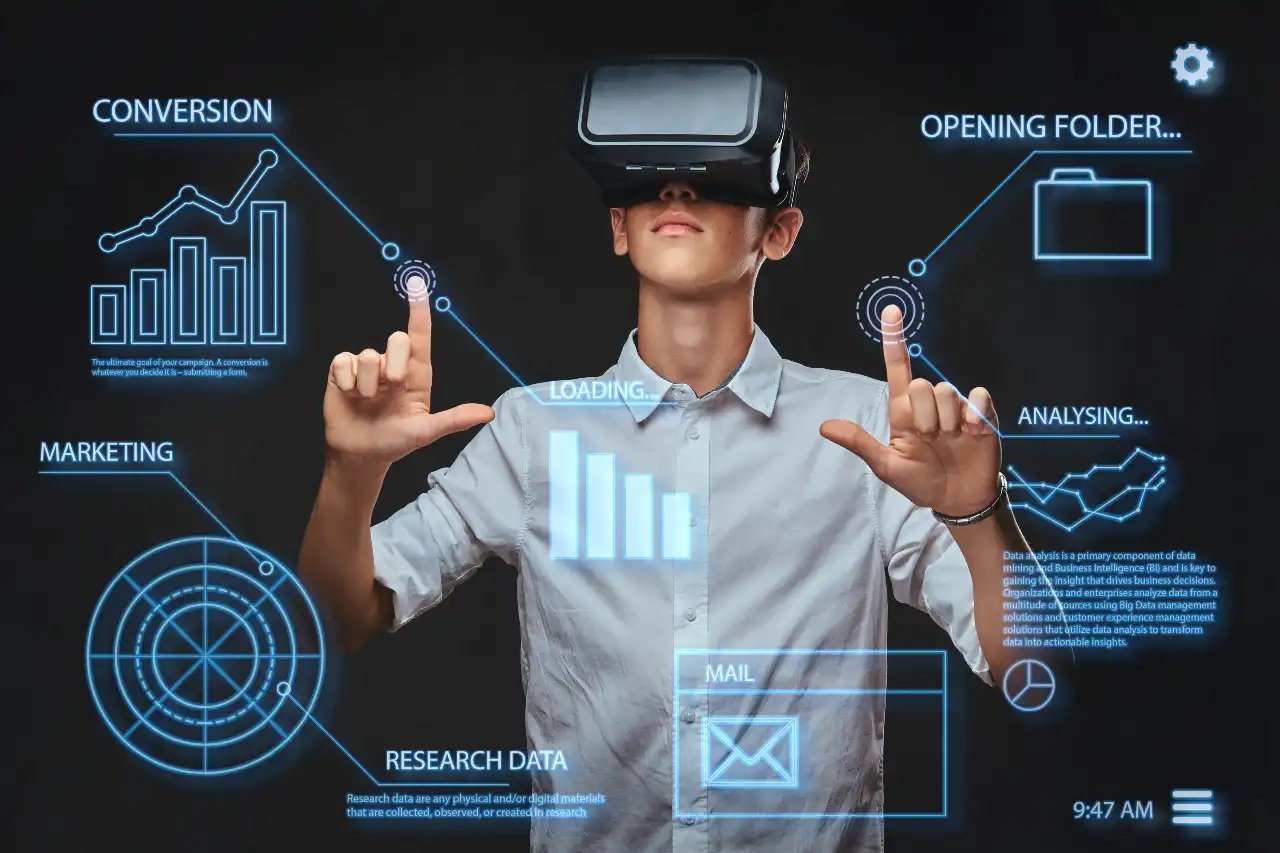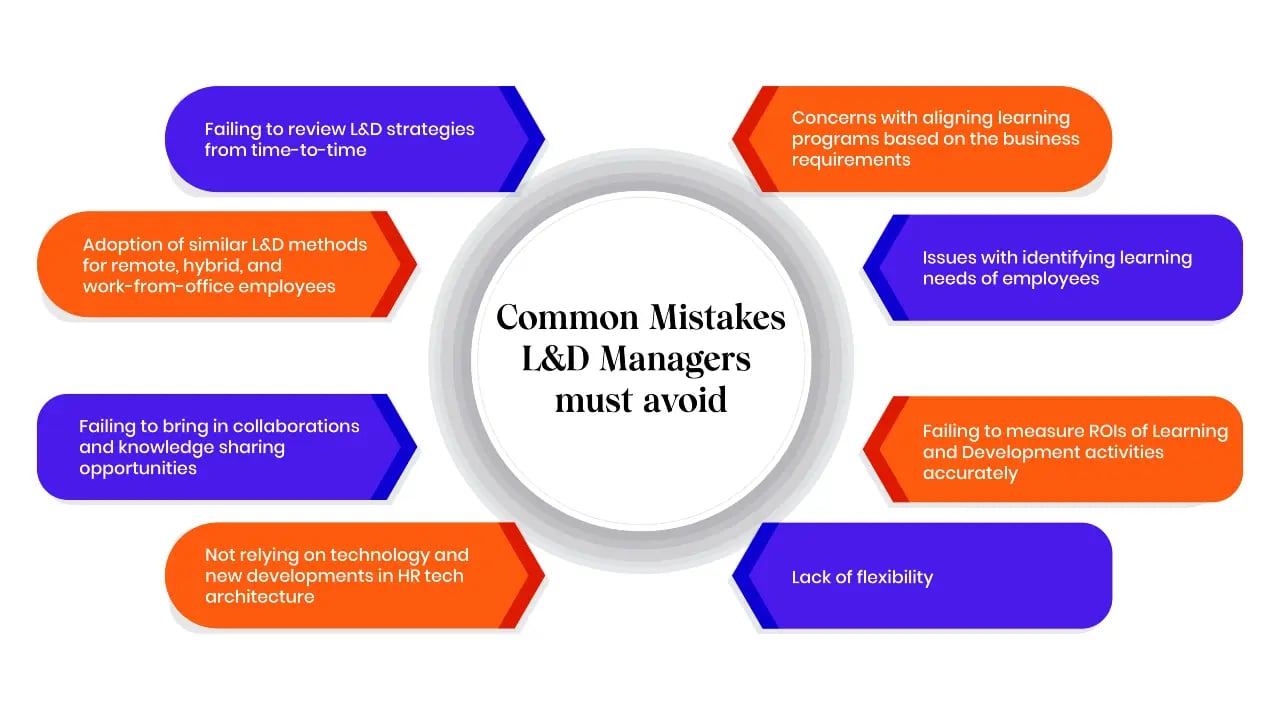Being an L&D professional comes with its challenges. As a core foundation of your organization’s growth, an effective L&D strategy can improve employee retention, engagement, performance, skills proficiencies, etc. But, sometimes, mistakes can happen, hampering the L&D processes. However, if you have clarity on these mistakes beforehand, you can review and resolve them quickly.
This blog will walk you through some common mistakes L&D managers must avoid. So, why don’t we get into the details?
Concerns with aligning learning programs based on the business requirements
It's not about the number of L&D programs conducted annually. It's the result achieved through these initiatives that matter. Some L&D professionals fail to consider this while creating organizational learning and development plans. Moving forward with achievements, one of the primary reasons for conducting L&D programs is attaining business growth.
For that purpose, it is essential to have your L&D programs aligned with your business requirements and goals. If not, it would impact your employees’ performance, hamper their learning experience, and, most importantly, cause concerns in attaining business targets.
As per Brandon Hall Group's 2020 Learning Strategy Study, 87% of the participants in the survey mentioned that L&D and business goal alignment need to be a priority. However, only 13% of them said they had acted upon them. Similarly, Josh Bersin has said only 10 to 15% of companies have L&D programs well-aligned with their business strategies.
So, how can your company align its L&D activities with your business strategy?
- By attaining an in-depth understanding of your short-term and long-term business goals and strategies
- Initiating proper communication with your company's leadership and management to ensure your learning programs align with your business goals, positioning, and required outcomes
- Measuring the RoI of your learning programs to ensure learning programs are impacting business goals
Issues with identifying the learning needs of employees
As per a recent survey that involved 1500 managers, 75% stated that they were dissatisfied with the L&D programs provided by their companies. This can be further substantiated by a Gartner survey involving 7,101 employees, where only 29% of the participants agreed that their company's L&D initiatives offer relevant learning solutions.
To cut a long story short, there are different reasons, ranging from lack of alignment with career objectives and learning needs to concern with the practical workspace application of these learning programs, that make employees unsatisfied with their company's L&D initiatives.
When things like these happen, it increases employee turnover, impacting retention. It is because, in today's world, employees are much more concerned about career advancement opportunities than salary. This is decipherable from a study published in Forbes, where 55% of employed participants stated they value career growth over income.
How can your organization emphasize its employee learning needs by overcoming this issue?
- By openly communicating with your employees and understanding their career goals
- By identifying skills and performance gaps by relying on current HR technologies like skills intelligence from which, you can make data-driven talent decisions
- By improving your understanding of the changes happening within the skills universe
- By moving away from traditional training methods and bringing in collaborative, peer-based, experience-oriented, and practical learning measures
By adopting these measures, L&D managers like you can identify your employees' learning needs and align your L&D strategies accordingly.
Failing to measure the RoI of learning and development activities accurately 
In 2022, 49% of organizations increased their L&D budgets compared to the previous years, as per an HR leaders survey conducted by Capterra. While making such hefty investments in L&D, measuring these activities' return on investment (RoI) is vital.
But, one of the common mistakes made by L&D professionals is that they fail to measure the ROIs of their L&D programs. It is mainly because there is a lack of clarity on measuring these programs, as each training program is unique in its own way.
Previously, organizations measured the ROI based on the number of attendees, surveys, etc. As per a research survey including 4000 respondents published by Statista in February 2018, 43% of the participants replied that their organization opted for qualitative employee surveys for measuring L&D activity's ROI. Other metrics adopted include:
- Employee satisfaction
- Talent mobility
- Productivity
- Engagement
- Reduction in skills gaps
- Proficiency
- Feedback
- Course completion
Another way to measure ROI is based on setting Key Performance Indicators or KPIs, including business, learning, and operational excellence. You can also rely on skills validation and skills intelligence to analyze and measure the results unbiasedly and accurately.
Lack of flexibility
Flexibility and agility are crucial in upskilling, reskilling, or other L&D activities. For instance, consider your company intends to have a training program for your employees and provide them with two options.
- The training would be a mandatory three-day on-site program, where employees would have to find a workaround with their busy schedules and deadlines to attend the program.
- Your employees can attend a similar training program online at their pace, giving them control over their learning.
So, what would a majority of your employees choose?
Undoubtedly, most employees would prefer flexibility and an opportunity to learn independently. This can be further substantiated by a research study by FinanceOnline, where 58% of the respondents stated that they prefer to learn at their own pace.

How can you bring flexibility to L&D activities?
You can do so via:
- Mobile learning
- Remote LMS
- Concept-based learning
- Personalized learning paths
- Microlearning
- Blended learning
- Immersive technology
- Virtual training
Besides this, it is essential to bring functional flexibility to your L&D initiatives. As per Gartner, only 36% of employees who participated in a survey of 7,101 employees said that their companies facilitate easily accessible L&D measures.
How can you bring functional flexibility to your L&D initiatives?
According to Gartner, you can overcome this functional issue by:
- Iterating outdated content
- Creating dynamic learning strategies
- Forming progressive skills portfolios
Failing to review L&D strategies from time-to-time
Following a decade-old L&D strategy can harm your organization more than benefit you because skills, jobs, and the way of work are changing drastically. Therefore, reviewing your L&D strategies regularly is one way to stay up-to-date and relevant. While doing so, here are a few things to consider to ensure its effectiveness:
- Understand your business requirements and goals
- Gain clarity on the skills required for your organization
- Conduct a skills gap analysis to identify skills, capability, and performance gaps
- Focus on creating contextual learning programs
- Make use of technology
- Measure the effectiveness of the programs via KPIs and feedback systems
What benefits can you attain by regularly reviewing your company’s L&D strategies?
- Save time and money
- Align your L&D strategy with your business goals
- Ensure your employees are receiving relevant training suitable for gaining career advancements
- Improve employee productivity
- Enhance employee retention and attraction
- Grow your company’s brand and reputation
Adoption of similar L&D methods for remote, hybrid, and work-from-office employees
Most of us learned about remote and hybrid work cultures with the shift brought in by the pandemic. But, in reality, it was a concept that evolved in the late 1900s. Today, there is a drastic increase in the adoption of these two work cultures, and organizations have to develop their strategies, including their L&D plans, to ensure that it's inclusive.
Using the same L&D strategy for remote and on-site employees is a common mistake made by L&D professionals. For instance, consider that your organization has on-site and remote employees, and your company conducts a leadership training program for all your employees. In this scenario, the remote employees would watch the on-site program live streaming. This would hamper the effectiveness of the program.
To overcome such a pitfall, organizations must curate specialized learning plans and adopt technology to make learning inclusive for all learners.
Failing to bring in collaboration and knowledge-sharing opportunities
Internal collaboration and knowledge-sharing platforms are two effective ways to enhance peer-to-peer learning and institutional knowledge within your company. Failing to consider these two measures as priorities can be two grave mistakes made by L&D professionals.
With increased remote work culture, internal collaboration can reduce the chances of employees working in silos, impacting business growth. Employees collaborating in L&D practices can help them interact, communicate, and learn better.
Knowledge sharing is also a collaborative peer-learning initiative where you can retain and build institutional knowledge. By conducting internal knowledge-sharing sessions, your employees can better understand your company’s positioning, values, products, or services. Apart from these internal training sessions, you can preserve institutional knowledge through personal mentorship programs.
So, what are the benefits of bringing collaboration and knowledge-sharing to your L&D strategy?
- Improve employee engagement and satisfaction
- Enhance productivity
- Help with succession planning
- Foster internal mobility
- Identify potential leaders/SMEs
Not relying on technology and new developments in HR tech architecture 
Several innovations are happening within the world of Learning and Development, from cloud-based learning platforms to deep learning through Artificial Intelligence. As an L&D professional, being unaware of these developments and failing to incorporate them into your L&D strategies could impact the effectiveness of your L&D programs.
What are the benefits of relying on HR tech for L&D?
- Improve the accuracy of the measurable results gained.
- Enhance flexibility and make learning a fun-filled experience for your employees, especially with the adoption of gamification.
- Build the integrity of your L&D activities.
- Offer L&D in a much more interactive way and bring in mobile learning measures, allowing your employees to learn from anywhere.
- Provide personalized learning opportunities to your employees.
You can reap these benefits, especially when popular HR technologies are incorporated within your HR functionalities.
What are some HR technologies to improve your L&D activities?
- Cloud-based learning platforms, facilitating an immersive and personalized learning experience
- AI-based skills intelligence platform for making intelligent talent decisions
- Skills validation and assessments
- Virtual reality
- Remote LMS
- Gamification
- AI-based deep learning
Thus, if you are an L&D professional, it is time to make the best out of technology to stay ahead of your competition and to be on par with the changes happening within the skills landscape.
Final thoughts
Thus, by avoiding these L&D mistakes, you can future-proof your talent and build a skill-fit talent pool aligning with your business goals and requirements.
So, why not improve your L&D strategies and programs to optimize your employees' learning and development activities and attain sustainable business growth?
|
Want to future-proof your talent with the right learning and development tools? Try iMocha! |
References
- Wentworth, D. (2021, November 1). Aligning the L&D Strategy With Business Goals. Brandon Hall Group. https://www.brandonhall.com/blogs/aligning-the-ld-strategy-with-business-goals/
- Shanahan, A. (n.d.). How to Connect Employee Skills With Organizational Strategy. https://www.docebo.com/learning-network/blog/learning-strategy-business-goals/#:~:text=According%20to%20L%26D%20guru%20Josh%20Bersin%2C%20only%2010-15%25,key%20business%20metrics%20compared%20to%20those%20that%20don%E2%80%99t.
- Beer, M., Finnstrom, M., & Schrader, D. (n.d.). Why Leadership Training Fails—And What to Do About It. HBR. https://hbr.org/2016/10/why-leadership-training-fails-and-what-to-do-about-it
- Joseph, S. V. (2019, August 15). The Secrets To Keeping Employees Engaged And Productive. https://www.forbes.com/sites/shelcyvjoseph/2019/08/15/the-secrets-to-keeping-employees-engaged-and-productive/?sh=3c186d1e4310
- Joseph, S. V. (2020, October 20). Recession and Automation Changes Our Future of Work, But There are Jobs Coming, Report Says. World Economic Forum. https://www.weforum.org/press/2020/10/recession-and-automation-changes-our-future-of-work-but-there-are-jobs-coming-report-says-52c5162fce
- Statista (n.d.). What are the top ways you measure the success of learning and development (L&D) at your company? https://www.statista.com/statistics/671285/ways-organizations-measure-of-companys-l-and-d-success/
- Westfall, B. (n.d.). To Close Skill Gaps, Nearly 50% of Companies Are Spending More on Upskilling Employees in 2022. https://www.capterra.com/resources/upskilling-employees-research/#methodology
- Gilbert, N. (n.d.). 76 Essential LMS & eLearning Statistics: 2021 Market Share & Data Analysis. https://financesonline.com/25-essential-learning-management-system-e-learning-statistics-analysis-of-trends-data-and-market-share/
- Gartner (n.d.). Building a Flexible L&D Function How to improve functional flexibility to bridge skill gaps. https://www.gartner.com/en/human-resources/trends/building-a-flexible-l-d-function
- Brassey, J., Christensen, L., & Dam, N. V. (2019, February 13). The essential components of a successful L&D strategy. https://www.mckinsey.com/capabilities/people-and-organizational-performance/our-insights/the-essential-components-of-a-successful-l-and-d-strategy


